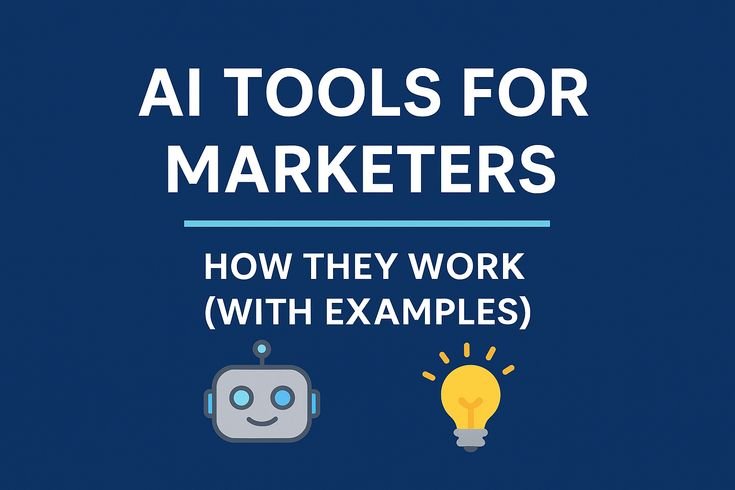1. Introduction to AI Marketing Tools
Not too long ago, marketing meant endless brainstorming sessions, sticky notes all over the wall, and heated debates over whether the “Buy Now” button should be green or red. Today? That same decision might be made by an algorithm in under a second—no coffee, no sticky notes, no arguing.
This is the world of AI marketing tools. They’re the quiet engine behind the ads that feel almost psychic, the product recommendations that know you better than your spouse, and the chatbots that somehow answer your questions at 3 a.m. They’re powerful, sometimes a little creepy, but undeniably effective.
2. Definition and Overview
So what are we talking about, really? AI marketing tools are software applications that use artificial intelligence to automate, optimize, and sometimes completely transform marketing tasks.
They can:
Write social media captions.
Suggest which customers are most likely to buy.
Automate emails so precisely they land in your inbox at the exact time you’re most likely to open them.
If traditional marketing was like fishing with a net, AI marketing tools are more like using a drone that tells you where the fish are, what bait to use, and even predicts how many you’ll catch.
3. Historical Context and Evolution
Back in the early 2000s, digital marketing was mostly about email blasts and Google AdWords. The tools were helpful but, let’s be honest, pretty basic. Then data analytics came along, and marketers could finally say, “Hey, this campaign worked!” instead of guessing.
Fast forward, and AI entered the room like a game-changer. Suddenly, it wasn’t just about tracking data but predicting what customers would do next. The jump from “what happened” to “what will happen” is where AI marketing tools truly evolved.
4. How AI Marketing Tools Work
Key Technologies
Natural Language Processing (NLP): Powers those eerily good chatbots.
Machine Learning: Learns from customer behavior and adapts campaigns.
Predictive Analytics: Tells you which leads are worth chasing.
Recommendation Engines: The reason Amazon always knows what you “need.”
Training Process
AI marketing tools don’t wake up one day and decide they’re geniuses. They’re trained on mountains of data—clicks, purchases, browsing habits. Every interaction helps them get smarter, a bit like teaching a puppy tricks, except the puppy never forgets and doesn’t chew your shoes.
5. Types of AI Marketing Tools
Content Creation Tools: They write blogs, ad copy, product descriptions.
SEO Optimizers: Help you climb the Google mountain.
Social Media Managers: Automate posts and track engagement.
Email Marketing Tools: Personalize every subject line and send time.
Ad Targeting Platforms: Deliver laser-focused ads instead of throwing spaghetti at the wall.
Analytics Dashboards: Give you a bird’s-eye view of what’s working.
Chatbots: Handle customer service without needing vacation days.
6. Applications
Let’s get practical. Here’s how these tools show up in real businesses:
E-commerce: Product recommendations that somehow match your late-night scrolling habits.
Travel: Airlines adjusting ticket prices minute by minute.
Social Media: AI suggesting that oddly perfect TikTok hashtag.
Customer Support: Bots answering FAQs so humans can handle real problems.
Lead Generation: Sorting hot leads from “just browsing.”
7. Benefits and Challenges
Advantages
Efficiency: Tedious tasks vanish.
Personalization: Customers feel seen, not spammed.
Data Insights: No more guessing games.
Scalability: Campaigns run across dozens of platforms without chaos.
Challenges
Privacy Concerns: How much data is too much?
Over-Reliance: Marketers risk outsourcing creativity.
Bias in Data: AI learns our flaws too.
Cost: The best tools don’t come cheap.
Trust: Customers may wonder, “Am I talking to a bot right now?”
8. Ethical Considerations
Here’s where it gets tricky.
Transparency: Should companies admit when AI wrote that email?
Manipulation: At what point does “personalized” become “pushy”?
Job Impact: Will AI replace junior marketers or just free them from grunt work?
Privacy: Is it ethical to track someone’s every digital move just to sell them shoes?
9. Popular Tools and How They Work
Jasper AI: Helps marketers draft blog posts and ads.
HubSpot: Combines AI with customer relationship management.
SurferSEO: Guides you toward search engine success.
Hootsuite Insights: Monitors social chatter about your brand.
Persado: Creates emotionally intelligent ad copy.
Drift: A chatbot that feels almost conversational.
10. Future Trends
Voice Search Optimization: Because more people talk to Alexa than their neighbors.
AI Video Editing: Creating personalized video ads at scale.
Predictive Campaigns: AI not just analyzing campaigns but designing them.
Hyper-Personalization: Ads that don’t just know your name but your mood.
Ethical AI Labels: A stamp that says “Yes, this ad was AI-generated.”
11. Case Studies and Success Stories
Spotify: AI-curated playlists that keep you listening—and advertisers happy.
Sephora: Chatbots giving personalized beauty advice.
Netflix: Recommendation engine that practically dares you to stop watching.
Coca-Cola: AI analyzing trends to create new product ideas.
Small Businesses: Using AI email tools to compete with giants.
12. Conclusion and Key Takeaways
AI marketing tools aren’t here to replace humans. They’re here to supercharge them. Think of them less like a threat and more like power tools—you still need the craftsman, but the drill helps a lot.
Key takeaway: Use AI for efficiency and insights, but keep the creativity, humor, and empathy human. That’s what makes marketing magic.
13. Frequently Asked Questions (FAQ)
Q1: Can AI replace marketers completely?
No. It handles tasks, but strategy and creativity remain human territory.
Q2: Are these tools affordable?
Some are budget-friendly; others are enterprise-level and pricey.
Q3: Do they guarantee results?
No tool guarantees success—it depends on how you use it.
Q4: Are AI tools safe for customer data?
Reputable ones follow privacy rules, but businesses must be cautious.
Q5: What’s next for AI marketing?
Smarter personalization, ethical guidelines, and tools that feel less robotic.
